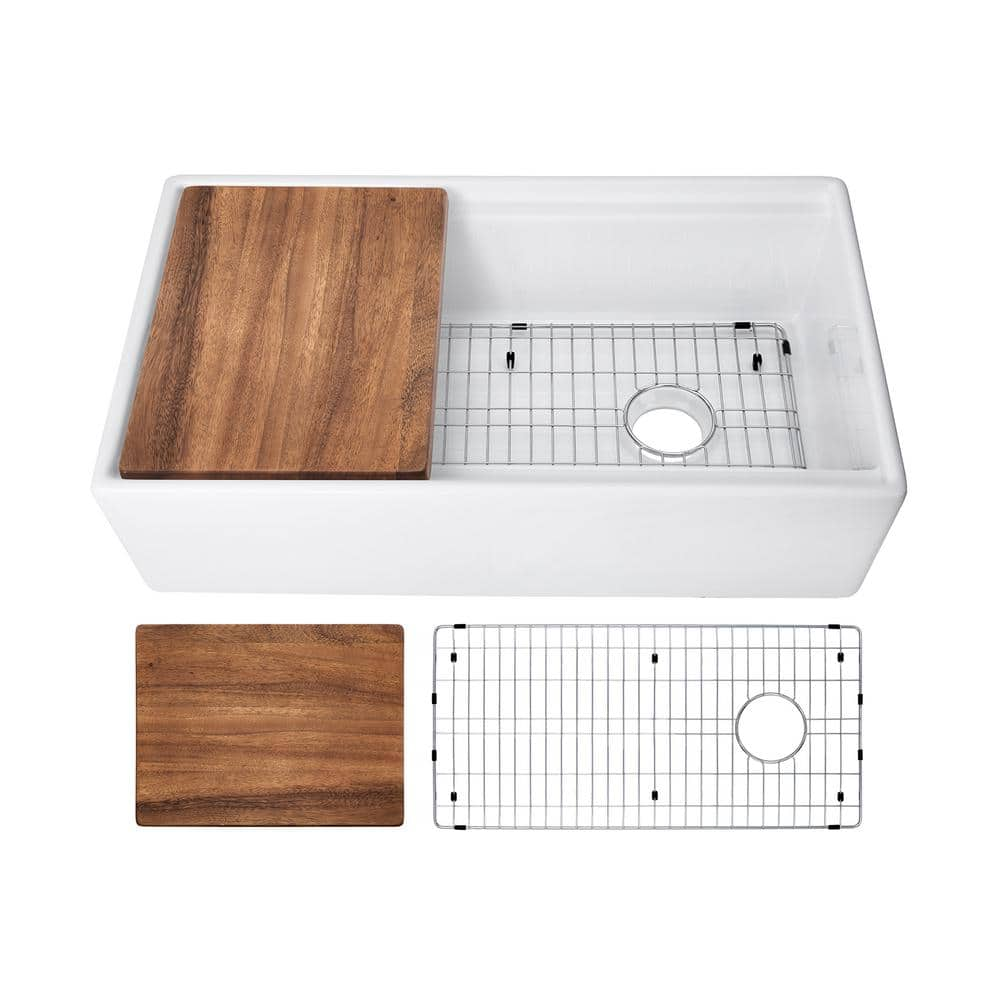IPT Sink Company Fireclay 36 in. Single Bowl Farmhouse Apron Front Reversible Kitchen Sink in White with Cutting Board and Grid
Includes cutting board and basin rack. Glazed white finish complements classic and contemporary kitchens. Suitable for installation with 40 in. cabinets.
Enduring in beauty and performance, this apron front kitchen sink is a fashionable kitchen fixture with modern farmhouse charm. The white sink is sculpted from fireclay and exposed to extreme temperatures, developing a smooth enamel finish that’s strong, stain resistant and stands up to everyday use. An inset ledge within the sink basin provides a seamless shelf for a dark wood cutting board that’s perfect for prep. The versatile undermount format can be installed as floating sink or flush beside kitchen cabinetry. Crafted by hand with exceptional care, subtle design details throughout the rectangular basin and apron front panel enhance the sink’s artisanal appearance.
- Fireclay sink features a fade-resistant white glazed finish stays shiny and bright for years to come
- Reversible installation allows for sink drainage on the right or the left side
- Large rectangular basin offers maximum volume for soaking pots and pans
- Glossy white farmhouse style complements classic and contemporary kitchen design
- Zero faucet holes allows for true customization of the placement of the kitchen faucet, soap dispenser and accessories
- Includes 1 sink, 1 cutting board and 1 stainless steel grid
- Drain assembly not included
- Dark wood cutting board maximizes countertop space with a durable and decorative work surface that’s perfect for food prep
- Stainless steel grid protects the glossy white basin surface from scratching while elevating pots and pans
- Complements classic and contemporary kitchen design
- Suitable for residential use only
Additional information
| Actual Left to Right Length (In.) | 36 |
|---|---|
| Bowl Below Counter Depth (in.) | 9 |
| Bowl Front to Back Width (in.) | 15 |
| Bowl Left to Right Length (in.) | 33 |
| Bowl Top to Bottom Depth (in.) | 9 |
| Cut-Out Below Counter Depth (in.) | 10 |
| Cut-Out Depth (in.) | 17.5 |
| Cut-Out Width (in.) | 34.5 |
| Kitchen Sink Front to Back Width (In.) | 19 |
| Panel Height (in.) | 10 |
| Panel Width (in.) | 36 |
| Certifications and Listings | ETL Listed |
| Manufacturer Warranty | 1-Year Limited |






by Kelly
I love my sink! It’s just the right size. It’s beautiful! The wire rack at the bottom will keep it looking lovely, and the wood accent shelf adds warmth to the white sink.
by John
Amazing product. I would definitely recommend.
by Priya
When I purchased this sink, I had no idea what types of things to be aware of. Once the guys came to measure for countertops, I was made to realize what a terrible product I had. It has many imperfections that are noticeable, it does not have straight sides, they are very curved, like a banana. It also does not measure the same at each end. If you raise one side the opposite side becomes unbalanced. This is quite a big deal and will be very noticeable once the countertops are installed. I have now been without a working sink for over a month and I didn’t return this one because it would’ve casued further delays with our countertop installation. I would not recommend this product.
by Steve
I LOVE MY NEW SINK!!! It is huge and wonderful.